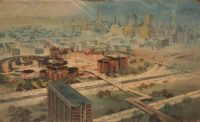Walter Netsch, 88, Leaves Behind a Complex Legacy

Walter Netsch
Burj Al Alam, at left (108 stories; 1,645 feet).
Image courtesy Fortune Group

Walter Netsch
Al Burj (projected between 180 and 228 stories; 3,400 to 4,590 feet).
Image courtesy Pei Partnership

Walter Netsch
Princess Tower (107 stories; 1,360 feet).
Image courtesy Tameer

Walter Netsch
Princess Tower (107 stories; 1,360 feet).
Image courtesy Tameer

Walter Netsch
Princess Tower (107 stories; 1,360 feet).
Image courtesy Tameer

Walter Netsch
Burj Dubai (162-stories; 2,680 feet).
Image courtesy SOM

Walter Netsch
Pentominium (120 stories; 1,690 feet).

Walter Netsch
Pentominium (120 stories; 1,690 feet).
Image courtesy Aedas

Walter Netsch
Al Sharq (102 stories; 1,180 feet).
Image courtesy SOM

Walter Netsch
Al Sharq (102 stories; 1,180 feet).
Image courtesy SOM





Post a comment to this article
Report Abusive Comment